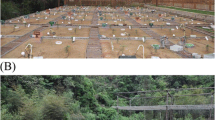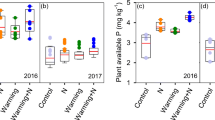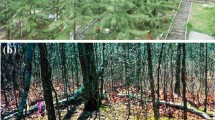Abstract
Background and aims
Global warming is a major global issue that may affect nutrient cycling in terrestrial ecosystems. Plants usually employ the strategy of nutrient resorption to conserve resources. Over the past few decades, there has been widespread attention given to how warming affects the nutrient resorption efficiency (NuRE) in leaves. Twig is another important component of plant. The unique physiological characteristics of twig may make its NuRE response to warming different from that of leaf. However, there is insufficient knowledge regarding how warming affects NuRE in twigs.
Methods
We assessed the response of nutrient concentrations (nitrogen, phosphorus, potassium, calcium, and magnesium) and NuREs in leaves and twigs to warming, by using plant samples (Cunninghamia lanceolata) from a manipulative field warming experiment (+ 5 °C).
Results
The nutrient concentrations and NuREs of leaves remained unchanged under warming. In contrast, warming significantly decreased nitrogen concentration (− 13%) and increased calcium (+ 21%) and magnesium (+ 44%) concentrations in mature twigs. Warming significantly decreased NRE (− 10%), KRE (− 15%), and CaRE (− 7%), and increased MgRE (+ 12%) in twigs. It was also found that warming decreased the water content of twigs, and there were significant negative correlations between NuREs and nutrients in senesced organs.
Conclusion
The nutrient concentrations and NuRE of twigs are more vulnerable to warming than those of leaves. The regulation of NuRE response to warming is influenced by water and nutrients. Incorporating plant twig NuRE into nutrient cycling modeling and ecosystem productivity predictions may improve the accuracy of predictions under future warming conditions.





Similar content being viewed by others
Data availability
Data will be made available on request.
References
Aerts R (1996) Nutrient resorption from senescing leaves of perennials: are there general patterns? J Ecol 84:597–608. https://doi.org/10.2307/2261481
Aerts R, Chapin FS (1999) The mineral nutrition of wild plants revisited: a re-evaluation of processes and patterns. Adv Ecol Res 30:1–67. https://doi.org/10.1016/S0065-2504(08)60016-1
Aerts R, Cornelissen JHC, van Logtesijin RSP, Callaghan TV (2007) Climate change has only a minor impact on nutrient resorption parameters in a high-latitude peatland. Oecologia 151:132–139. https://doi.org/10.1007/s00442-006-0575-0
Bauters M, Janssens IA, Wasner D, Doetterl S, Vermeir P, Griepentrog M, Drake TW, Six J, Barthel M, Baumgartner S, Oost KV, Makelele LA, Ewango C, Verheyen K, Boeckx P (2022) Increasing calcium scarcity along Afrotropical forest succession. Nat Ecol Evol 6:1122–1131. https://doi.org/10.1038/s41559-022-01810-2
Cavaleri MA, Reed SC, Smith WK, Wood TE (2015) Urgent need for warming experiments in tropical forests. Glob Change Biol 21:2111–2121. https://doi.org/10.1111/gcb.12860
Chapin SF, Kedrowski AR (1983) Seasonal changes in nitrogen and phosphorus fractions and autumn retranslocation in evergreen and deciduous taiga trees. Ecology 64:376–391. https://doi.org/10.2307/1937083
Chen X, Chen HYH (2022) Foliar nutrient resorption dynamics of trembling aspen and white birch during secondary succession in the boreal forest of central Canada. For Ecol Manag 505:119876. https://doi.org/10.1016/j.foreco.2021.119876
Chen ZC, Peng WT, Li J, Hong L (2018) Functional dissection and transport mechanism of magnesium in plants. Semin Cell Dev Biol 74:142–152. https://doi.org/10.1016/j.semcdb.2017.08.005
Chen H, Reed SC, Lü XT, Xiao KC, Wang KL, Li DJ (2021) Global resorption efficiencies of trace elements in leaves of terrestrial plants. Funct Ecol 35:1596–1602. https://doi.org/10.1111/1365-2435.13809
Clarkson DT (1984) Calcium transport between tissues and its distribution in the plant. Plant Cell Environ 7:449–456. https://doi.org/10.1111/j.1365-3040.1984.tb01435.x
Craine JM, Elmore AJ, Wang L, Aranibar J, Bauters M, Boeckx P, Crowley BE, Dawes MA, Delzon S, Fajardo A, Fang Y, Fujiyoshi L, Gray A, Guerrieri R, Gundale MJ, Hawke DJ, Hietz P, Jonard M, Kearsley E, Zmudczyńska-Skarbek K (2018) Isotopic evidence for oligotrophication of terrestrial ecosystems. Nat Ecol Evol 2:1735–1744. https://doi.org/10.1038/s41559-018-0694-0
Dawes MA, Schleppi P, Hattenschwiler S, Rixen C, Hagedorn F (2017) Soil warming opens the nitrogen cycle at the alpine treeline. Glob Change Biol 23:421–434. https://doi.org/10.1111/gcb.13365
de Campos M, Antonangelo JA, Alleoni LRF (2016) Phosphorus sorption index in humid tropical soils. Soil Tillage Res 156:110–118. https://doi.org/10.1016/j.still.2015.09.020
Deng M, Liu L, Jiang L, Liu W, Wang X, Li S, Yang S, Wang B (2018) Ecosystem scale trade-off in nitrogen acquisition pathways. Nat Ecol Evol 2:1724–1734. https://doi.org/10.1038/s41559-018-0677-1
Ding Y, Luo W, Xu G (2006) Characterisation of magnesium nutrition and interaction of magnesium and potassium in rice. Ann Appl Biol 149:111–123. https://doi.org/10.1111/j.1744-7348.2006.00080.x
Du EZ, Terrer C, Pellegrini AFA, Ahlström A, van Lissa CJ, Zhao X, Xia N, Wu X, Jackson RB (2020) Global patterns of terrestrial nitrogen and phosphorus limitation. Nat Geosci 13:221–226. https://doi.org/10.1038/s41561-019-0530-4
FAO (2006) Global forest resource assessment. Food and Agricultural Organization of the United Nations. Rome
Freschet GT, Cornelissen JHC, van Logtestijn RSP, Aerts R (2010) Substantial nutrient resorption from leaves, stems and roots in a subarctic flora: what is the link with other resource economics traits? New Phytol 186:879–889. https://doi.org/10.1111/j.1469-8137.2010.03228.x
Heineman KD, Turner BL, Dalling JW (2016) Variation in wood nutrients along a tropical soil fertility gradient. New Phytol 211:440–454. https://doi.org/10.1111/nph.13904
Huang H, Ran JZ, Ji MF, Wang ZQ, Dong LW, Hu WG, Deng Y, Hou C, Niklas KJ, Deng JM (2020) Water content quantitatively affects metabolic rates over the course of plant ontogeny. New Phytol 228:1524–1534. https://doi.org/10.1111/nph.16808
IPCC (2021) Summary for policymakers. In: Climate change 2021: the physical science basis. Contribution of Working Group I to the Sixth Assessment Report of the Intergovernmental Panel on Climate Change. Cambridge University Press, Cambridge, United Kingdom and New York, NY, USA, 2391 pp. https://doi.org/10.1017/9781009157896
Jiao CL, Zhang JH, Wang XC, He NP (2023) Plant magnesium on the Qinghai-Tibetan Plateau: Spatial patterns and influencing factors. Sci Total Environ 862:160743. https://doi.org/10.1016/j.scitotenv.2022.160743
Kerkhoff AJ, Fagan WF, Elser JJ, Enquist BJ (2006) Phylogenetic and growth form variation in the scaling of nitrogen and phosphorus in the seed plants. Am Nat 168:E103–E122. https://doi.org/10.1086/507879
Killingbeck KT (1996) Nutrients in senesced leaves: Keys to the search for potential resorption and resorption proficiency. Ecology 77:1716–1727. https://doi.org/10.2307/2265777
Lie Z, Huang W, Liu X, Zhou G, Yan J, Li Y, Huang C, Wu T, Fang X, Zhao M, Liu S, Chu G, Kadowaki K, Pan X, Liu J (2021) Warming leads to more closed nitrogen cycling in nitrogen-rich tropical forests. Glob Change Biol 27:664–674. https://doi.org/10.1111/gcb.15432
Liu WL, Jiang YL, Su Y, Smoak JM, Duan BL (2022) Warming affects soil nitrogen mineralization via changes in root exudation and associated soil microbial communities in a subalpine tree species Abies fabri. J Plant Nutr Soil Sci 22:406–415. https://doi.org/10.1111/1365-2435.14318
Lu X, Mao Q, Gilliam FS, Luo Y, Mo J (2014) Nitrogen deposition contributes to soil acidification in tropical ecosystems. Glob Change Biol 20:3790–3801. https://doi.org/10.1111/gcb.12665
Lyu M, Chen S, Zhang Q, Yang Z, Xie J, Wang C, Wang X, Liu X, Xiong D, Xu C, Lin W, Chen G, Chen Y, Yang Y (2024) Rapid positive response of young trees growth to warming reverses nitrogen loss from subtropical soil. Funct Ecol. https://doi.org/10.1111/1365-2435.14526
Nottingham AT, Meir P, Velasquez E, Benjamin L (2020) Turner soil carbon loss by experimental warming in a tropical forest. Nature 584:234–237. https://doi.org/10.1038/s41586-020-2566-4
Piao HC, Liu CQ (2011) Variations in nitrogen, zinc, and sugar concentrations in Chinese fir seedlings grown on shrubland and plowed soils in response to arbuscular mycorrhizae-mediated process. Biol Fertil 47:721–727. https://doi.org/10.1007/s00374-011-0538-4
Pratt RB, Black RA (2006) Do invasive trees have a hydraulic advantage over native trees? Biol Invasions 8:1331–1341. https://doi.org/10.1007/s10530-005-0422-y
Prieto I, Querejeta JI (2020) Simulated climate change decreases nutrient resorption from senescing leaves. Glob Change Biol 26:1795–1807. https://doi.org/10.1111/gcb.14914
Robinson D (2001) δ15N as an integrator of the nitrogen cycle. Trends Ecol Evol 16:153–162. https://doi.org/10.1016/S0169-5347(00)02098-X
Santiago LS, Wright SJ, Harms KE, Yavitt JB, Korine C, Garcia MN, Turner BL (2012) Tropical tree seedling growth responses to nitrogen, phosphorus and potassium addition. J Ecol 100:309–316. https://doi.org/10.1111/j.1365-2745.2011.01904.x
Sardans J, Peñuelas J (2015) Potassium: a neglected nutrient in global change. Global Ecol Biogeogr 24:261–275. https://doi.org/10.1111/geb.12259
Sardans J, Rivas-Ubach A, Peñuelas J (2012) The C:N: P stoichiometry of organisms and ecosystems in a changing world: a review and perspectives. Perspect Plant Ecol Evol Syst 14:33–47. https://doi.org/10.1016/j.ppees.2011.08.002
Shabbir R, Javed T, Hussain S, Ahmar S, Naz M, Zafar H, Pandey S, Chauhan J, Siddiqui MH, Chen PH (2022) Calcium homeostasis and potential roles in combatting environmental stresses in plants. S Afr J Bot 148:683–693. https://doi.org/10.1016/j.sajb.2022.05.038
Skinner PW, Matthews MA (1990) A novel interaction of magnesium translocation with the supply of phosphorus to roots of grapevine (Vitis vinifera L.). Plant Cell Environ 13:821–826. https://doi.org/10.1111/j.1365-3040.1990.tb01098.x
Stratton L, Goldstein G, Meinzer FC (2000) Stem water storage capacity and efficiency of water transport: their functional significance in a Hawaiian dry forest. Plant Cell Environ 23:99–106. https://doi.org/10.1046/j.1365-3040.2000.00533.x
Sun X, Kang H, Chen HYH, Björn B, Samuel BF, Liu C (2016) Biogeographic patterns of nutrient resorption from Quercus variabilis Blume leaves across China. Plant Biol 18:505–513. https://doi.org/10.1111/plb.12420
Sun XB, Li DJ, Lü XT, Fang YT, Ma ZL, Wang ZC, Chu CJ, Li MM, Chen H (2023) Widespread controls of leaf nutrient resorption by nutrient limitation and stoichiometry. Funct Ecol 37:1653–1662. https://doi.org/10.1111/1365-2435.14318
Suseela V, Tharayil N, Xing B, Dukes JS (2015) Warming and drought differentially influence the production and resorption of elemental and metabolic nitrogen pools in Quercus rubra. Glob Change Biol 21:4177–4195. https://doi.org/10.1111/gcb.13033
Vallano DM, Sparks JP (2013) Foliar δ15N is affected by foliar nitrogen uptake, soil nitrogen, and mycorrhizae along a nitrogen deposition gradient. Oecologia 172:47–58. https://doi.org/10.1007/s00442-012-2489-3
van Gestel N, Shi Z, van Groenigen KJ, Osenberg CW, Andresen LC, Dukes JS, Hovenden MJ, Luo YQ, Michelsen A, Pendall E, Reich PB, Schuur EAG, Hungate BA (2018) Predicting soil carbon loss with warming. Nature 554:E4–E5. https://doi.org/10.1038/nature25745
Van Heerwaarden LM, Toet S, Aerts R (2003) Nitrogen and phosphorus resorption efficiency and proficiency in six sub-arctic bog species after 4 years of nitrogen fertilization. J Ecol 91:1060–1070. https://doi.org/10.1111/gcb.15432
Vergutz L, Manzoni S, Porporato A, Ferreira R, Jackson RB (2012) Global resorption efficiencies and concentrations of carbon and nutrients in leaves of terrestrial plants. Ecol Monogr 82:205–220. https://doi.org/10.1890/11-0416.1
Walker TW, Adams AFR (1958) Studies on soil organic matter: I. Influence of phosphorus content of parent materials on accumulations of carbon, nitrogen, sulfur, and organic phosphorus in grassland soils. Soil Sci 85:307–318. https://doi.org/10.1097/00010694-195806000-00004
Wang Z, Huang H, Wang H, Peñuelas J, Sardans J, Niinemets Ü, Niklas KJ, Li Yan, Xie J, Wright IJ (2022) Leaf water content contributes to global leaf trait relationships. Nat Commun 13:5525. https://doi.org/10.1038/s41467-022-32784-1
Wright IJ, Westoby M (2003) Nutrient concentration, resorption and lifespan: leaf traits of Australian sclerophyll species. Funct Ecol 17:10–19. https://doi.org/10.1046/j.1365-2435.2003.00694.x
Xiong DC, Yang ZJ, Chen GS, Liu XF, Lin WS, Hang JX, Bowles FP, Lin CF, Xie JS, Li YQ, Yang YS (2018) Interactive effects of warming and nitrogen addition on fine root dynamics of a young subtropical plantation. Soil Biol Biochem 123:180–189. https://doi.org/10.1016/j.soilbio.2018.05.009
Yan XJ, Zhong BY, Chen TT, Zhang LH, Song TT, Chen GS (2019) Effects of air and soil warming on leaf functional traits of Cunninghamia lanceolata seedlings. Acta Ecol Sin 39:5653–5661. https://doi.org/10.5846/stxb201809232071
Yu L, Huang ZD, Li ZJ, Korpelainen H, Li CY (2022) Sex-specific strategies of nutrient resorption associated with leaf economics in Populus euphratica. J Ecol 110:2062–2073. https://doi.org/10.1111/1365-2745.13952
Yuan ZY, Chen HYH (2009) Global-scale patterns of nutrient resorption associated with latitude, temperature and precipitation. Global Ecol Biogeogr 18:11–18. https://doi.org/10.1111/j.1466-8238.2008.00425.x
Zhang QF, Xie JS, Lyu MK, Xiong DC, Wang J, Chen YM, Li YQ, Wang MK, Yang YS (2017) Short-term effects of soil warming and nitrogen addition on the N: P stoichiometry of Cunninghamia lanceolata in subtropical regions. Plant Soil 411:395–407. https://doi.org/10.1007/s11104-016-3037-4
Zhang QF, Yang ZJ, Chen TT, Gong XY, Xiong DC, Ye WM, Chen YM, Yang YS (2019a) Warming alters plant chemical and nutrient compositions by affecting metabolites in Cunninghamia lanceolata (Lamb.) Hook. Forests 10:553. https://doi.org/10.3390/f10070553
Zhang QF, Zhou JC, Li XJ, Yang ZJ, Zheng Y, Wang J, Lin WS, Xie JS, Chen YM, Yang YS (2019b) Are the combined effects of warming and drought on foliar C:N:P: K stoichiometry in a subtropical forest greater than their individual effects? For Ecol Manag 448:256–266. https://doi.org/10.1098/rspb.2022.1178
Zhang MX, Luo Y, Meng QQ, Han WX (2022) Correction of leaf nutrient resorption efficiency on the mass basis. J Plant Ecol 15:1125–1132. https://doi.org/10.1093/jpe/rtac041
Zhang H, Wang L, Jin X, Bian L, Ge Y (2023) High-throughput phenotyping of plant leaf morphological, physiological, and biochemical traits on multiple scales using optical sensing. CROP J 11:2214–5141. https://doi.org/10.1016/j.cj.2023.04.014
Zhao H, He N, Xu L, Zhang XM, Wang QF, Wang B, Yu G (2019) Variation in the nitrogen concentration of the leaf, branch, trunk, and root in vegetation in China. Ecol Indic 96:496–504. https://doi.org/10.1016/j.ecolind.2018.09.031
Zhao N, Yu GR, Wang QF, Wang RL, Zhang JH, Liu CC, He NP (2020) Conservative allocation strategy of multiple nutrients among major plant organs: from species to community. J Ecol 108:267–278. https://doi.org/10.1111/1365-2745.13256
Zheng W, Lin WS, Fan YX, Li YQ, Zhou JC, Zheng Y, Chen SD, Liu XF, Xiong DC, Xu C, Yang ZJ (2023) Divergent effects of short-term warming on microbial resource limitation between topsoil and subsoil in a young subtropical Chinese fir forest. Biogeochemistry 163:185–199. https://doi.org/10.1007/s10533-023-01022-1
Ziaco E, Liang EY (2019) New perspectives on sub-seasonal xylem anatomical responses to climatic variability. Trees 33:973–975. https://doi.org/10.1007/s00468-018-1786-9
Zong N, Shi PL, Chai X (2018) Effects of warming and nitrogen addition on nutrient resorption efficiency in an alpine meadow on the northern Tibetan Plateau. Soil Sci Plant Nutr 64:482–490. https://doi.org/10.1080/00380768.2018.1467727
Acknowledgements
This work was supported by the National Natural Science Foundation of China (32101330, 32192433, and 31988102) and the Opening Foundation of Laboratory for Earth Surface Processes, Ministry of Education. The authors declare that they have no known competing financial interests or personal relationships that could have appeared to influence the work reported in this paper.
Author information
Authors and Affiliations
Contributions
Qiufang Zhang, Zhijie Yang, Shidong Chen, Yuehmin Chen and Yusheng Yang conceived and designed the study; Qiufang Zhang and Decheng Xiong collected the samples; Hao Sun, Qiufang Zhang, Jiaojiao Ji analyzed the samples/data and wrote the manuscript; Zhijie Yang, Shidong Chen, Yuehmin Chen and Yusheng Yang revised the manuscript; all authors approved the final manuscript.
Corresponding authors
Additional information
Responsible Editor: Wenxuan Han.
Publisher's Note
Springer Nature remains neutral with regard to jurisdictional claims in published maps and institutional affiliations.
Rights and permissions
Springer Nature or its licensor (e.g. a society or other partner) holds exclusive rights to this article under a publishing agreement with the author(s) or other rightsholder(s); author self-archiving of the accepted manuscript version of this article is solely governed by the terms of such publishing agreement and applicable law.
About this article
Cite this article
Sun, H., Zhang, Q., Yang, Z. et al. Nutrient resorption efficiency of twigs is more vulnerable to warming than that of leaves of Cunninghamia lanceolata seedlings. Plant Soil (2024). https://doi.org/10.1007/s11104-024-06749-w
Received:
Accepted:
Published:
DOI: https://doi.org/10.1007/s11104-024-06749-w




